STRATIGRAFIE OPERATIVE
November 12 – December 12, 2023
Installation on board the ACTV vaporetto Line 1 and Line 2

Curatorial text by Costanza Sartoris
Stratigrafie operative: a cyclical flow in dialogue with the tide
Those who experienced firsthand the dramatic events of the night of November 12, 2019 in Venice remember the power of the wind with the strong gusts of rain, the incessant sound of the sirens announcing the high tide, and the lagoon growing out of proportion, swallowing up the city's shores and alleys. However, the image that has most remained imprinted in the community's collective memory of that event is the iconic photograph of the stranded boat, which found itself biased on the Riva degli Schiavoni once the tide had receded. A reminder of the power of water when it rises uncontrolled, a material and spectral trace of its violent passage.
Aiming to deepen and add meaning to images that are seemingly aesthetically devoid and often relegated to mere documentation of the events to which they refer, the group involved the Fire Department, Civil Defense, VERITAS, CNR Ismar, and the Municipality of Venice to identify materials that could offer an novel vision of the aqua granda of 2019. In November 2022, the collective held a workshop in the context of the exhibition Sulle Acque at the Chiesa delle Penitenti organized by AquaGranda. In that occasion, Giulia Bruno and Armin Linke dialogued with representatives of some of the Venetian institutions involved, who re-read through their own professional experience and personal memories a series of technical images they had used for logistical purposes. This way the documentary images took on additional meanings supported by explanatory narratives and annotations born out of the intimate dialogue created with the artists. This collegial process of rereading and reinterpretation of material used primarily for operational purposes is at the heart of the poetics of Giulia Bruno, Armin Linke and Lorenzo Mason, since it actualizes contemporary technical-scientific aesthetics as the bearer of cultural values strongly linked to the collective imagination.
Combining the three different lines of research of the members of the collective, respectively language understood as a technological tool, photography as an expression of an epoch, and graphics as a means of narrative experimentation, Stratigrafie Operative reactivates the memory related to the operational knowledge for the management of the emergency caused by the exceptional tide of 2019 through multiple layers. Just as the tide does not reach a single peak, but cyclically every six hours rises and in the next six it falls, the exceptional tide of 2019 submerged the city of Venice in multiple waves and for multiple days requiring continuous monitoring and work by technical personnel to manage the emergency. These offer parallels to the narrative process embodied by the work, which reactivates the collective memory and imagination with respect to the event in a cyclical way, in waves. The chosen images work on multiple levels that intersect known knowledge with technical and specialized narratives, where the point of view of those managing an emergency plan returns to the community. The chosen medium, a ferry boat, is a material emblem of this return to the community, as it embodies the everyday movements of those who inhabit and traverse the space of the city.
Moving between the canals, the artwork Stratigrafie Operative brings back the innumerable and multifaceted levels of interpretation that certain images trigger in the individual person. There, the gesturality of the annotations enters into dialogue with the image itself, transforming the document into a complex work. Like pictorial strokes, the annotations are superimposed on the known, becoming the material traces of a further narrative, able to offer a deviation from the primary meaning the image may have. A collective process that from a symbolic dialogue re-enters the intimate and material everydayness of fruition, always partial, never complete. The artwork-boat itself is in fact impossible to grasp in its entirety on a visual level: from the shore as a floating monument it tells certain stories, while on the inside it opens up other ones. A double narrative level that from panorama gathers to the intimacy of the space of the public vehicle and vice versa. A series of cross-references and returns with respect to that collective imaginary that continues to remain imprinted in all the people who traverse the history and fragility of the city of Venice: a cyclical flow in dialogue with the tide.
Stratigrafie Operative
The artistic project Stratigrafie operative was born from a dialogue initiated by Giulia Bruno, Armin Linke, and Lorenzo Mason in collaboration with the AquaGranda project. From its inception, AquaGranda has kept alive the memory of the Venetian community and its close connection with the tides, preserving and disseminating the memory of this coastal community affected by the effects of climate change. The digital archive of AquaGranda is a work of collective memory, a mosaic of perspectives on the extreme event of 2019, whose fragments are the memories of those who experienced it firsthand, or those who have spread or interpreted its media echo.
Over the past year and a half, the AquaGranda team has worked alongside the collective of artists consisting of Giulia Bruno, Armin Linke, and Lorenzo Mason to make those technical materials -that due to their reserved or operational nature had remained invisible until now- visible to the public. These materials have been held by local institutions and organizations that, on that occasion and on others, have operated to assist the population, mitigate the effects of the event, and make the city and the lagoon of Venice livable again.
These operational testimonies represent the keystone of collective memory because they are the spokespeople for a widespread but often tacit savoir-faire that is essential to fully understand and address extreme weather events like the one experienced in November 2019, both in Venice and in other coastal areas subject to similar phenomena.
To fully understand the nature and extent of an extraordinary tidal event it is necessary to identify those who were in the field in the most affected areas during the event, such as the island of Pellestrina, and collect the testimonies of those who worked, often tirelessly throughout the night, to protect the community and restore the livability of the city in the following days. Therefore, in collaboration with the artists, we activated the AquaGranda network to identify those who held these valuable operational testimonies.
This process of exploration and facilitation, which lasted several months, initiated a second phase of multimedia content collection, through a laboratory, curated by the collective and coordinated by the AquaGranda team. In that context, with the support of local institutions and organizations, the actors who were in the field during the event were involved. They commented on and annotated the collected materials, revealing behind-the-scenes details and technical insights that only an expert eye can see.
This process of participatory annotation, carried out on November 11 and 12, 2022, in the evocative setting of the Archiving Room of the multimedia exhibition Sulle Acque, brought out the materials later used by the collective to produce the artwork Stratigrafie operative.
What better media to convey the evocative power of this work than an ACTV vaporetto? Thanks to the collaboration between AquaGranda, VELA, and other local partners, a public public transport vehicle, one of the most affected by the devastation of the exceptional tide of 2019, now hosts these testimonies. Like the tide, this vehicle transformed by the artists acts as a public work of art, breaking into daily life. It is a stratigraphic work of operational materials and memories in transit through the canals of Venice, which, like climate change, can reach everywhere and concern everyone.
VAPORETTO
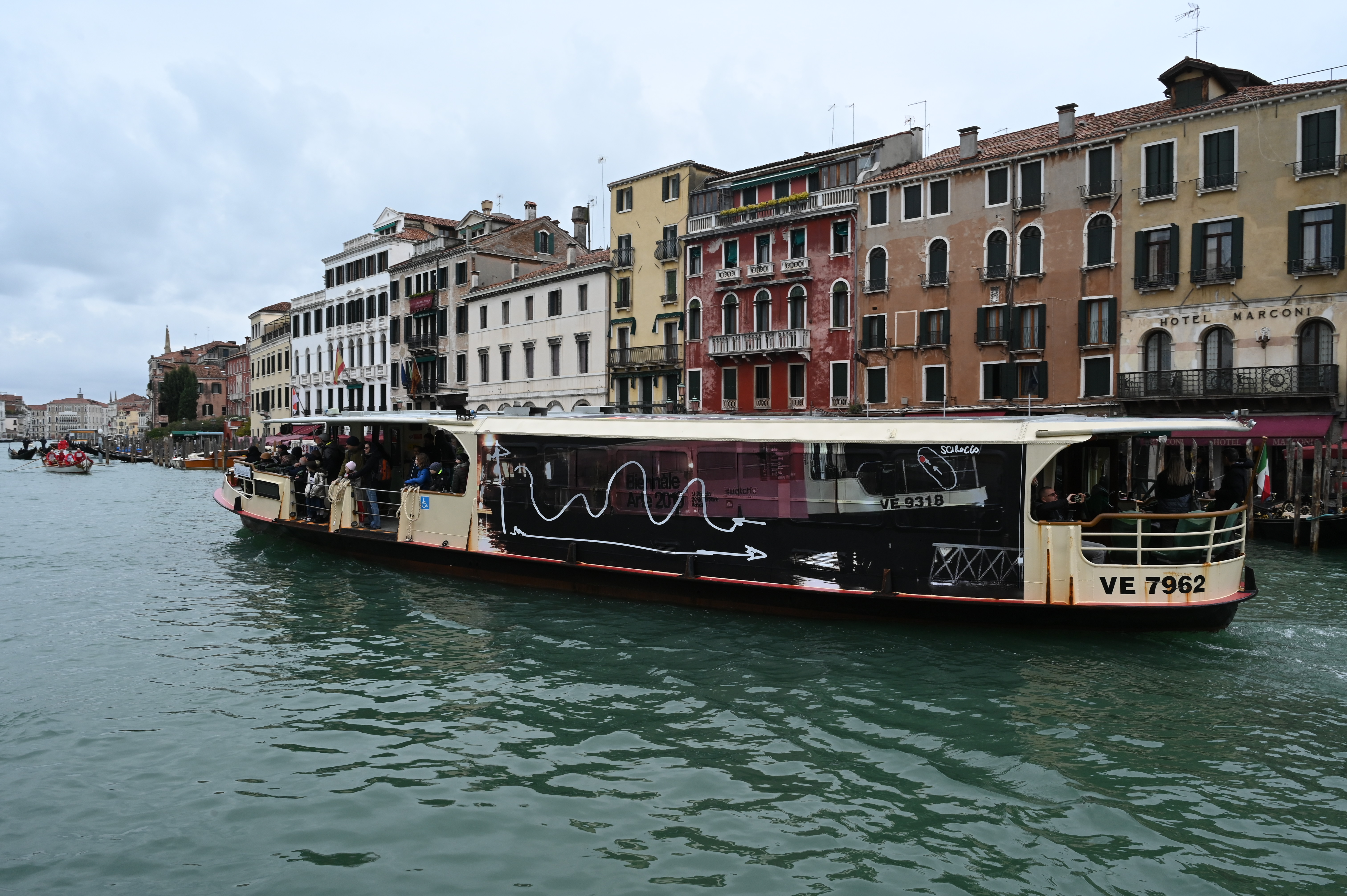
© Marco Sabadin
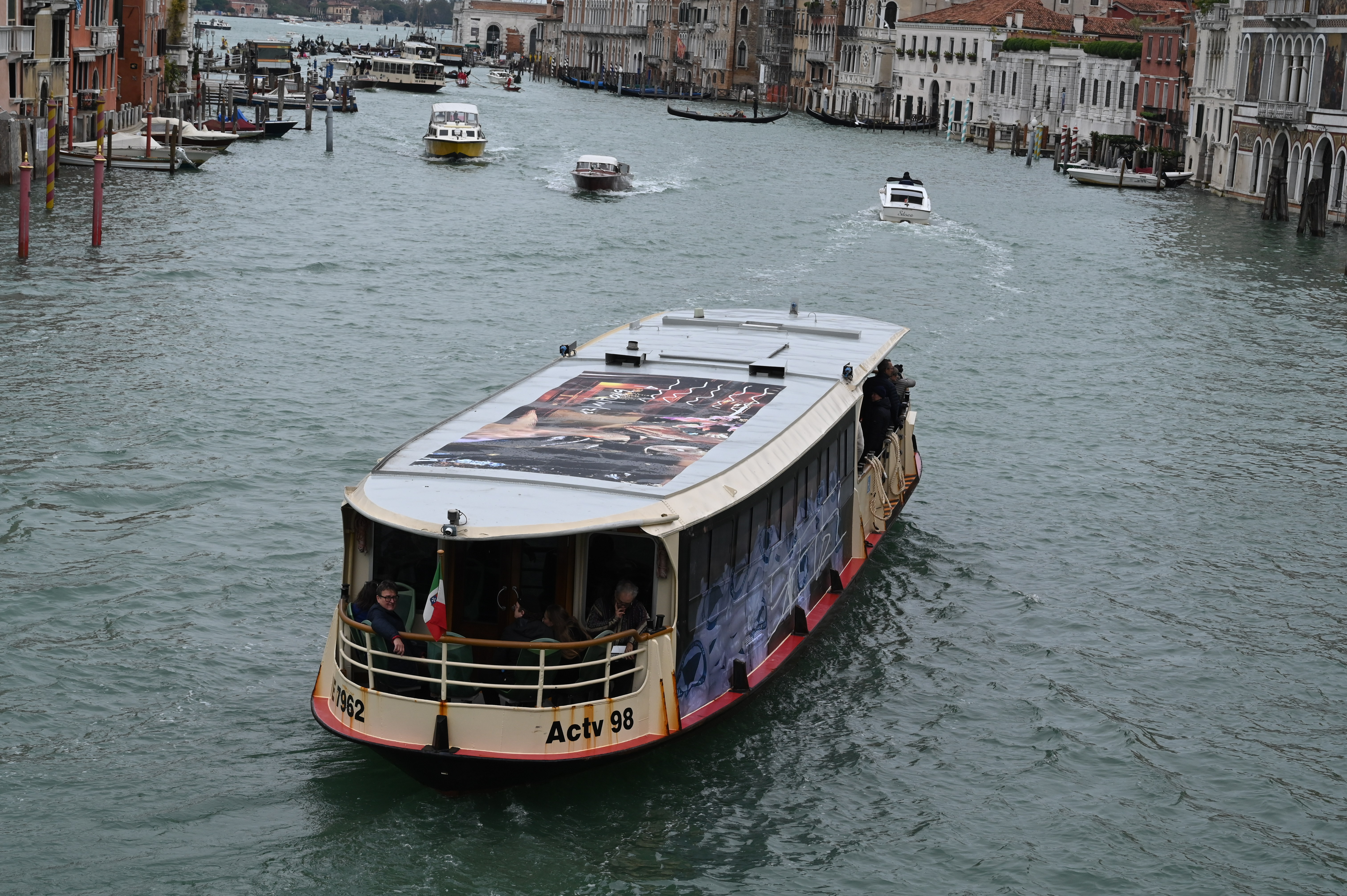
© Marco Sabadin
Timetables Line 1 Water Bus
- P. Roma 05.01 > Lido 05.59
- Lido 06.08 > P. Roma 07.13
- P. Roma 07.21 > Lido 08.26
- P. Roma 07.21 > Lido 08.26
- Lido 08.32 > P. Roma 09.37
- P. Roma 09.45 > Lido 10.50
- Lido 10.56 > P. Roma 12.01
- P. Roma 12.09 > Lido 13.14
- Lido 13.20 > P. Roma 14.25
- P.Roma 14.33 > Lido 15.38
- Lido 15.44 > P.Roma 16.49
- P.Roma 16.57 > Lido 18.02
- Lido 18.08 > P. Roma 19.13
- P. Roma 19.21 > Lido 20.26
- Lido 20.32 > P.Roma 21.37
Biographies
Giulia Bruno
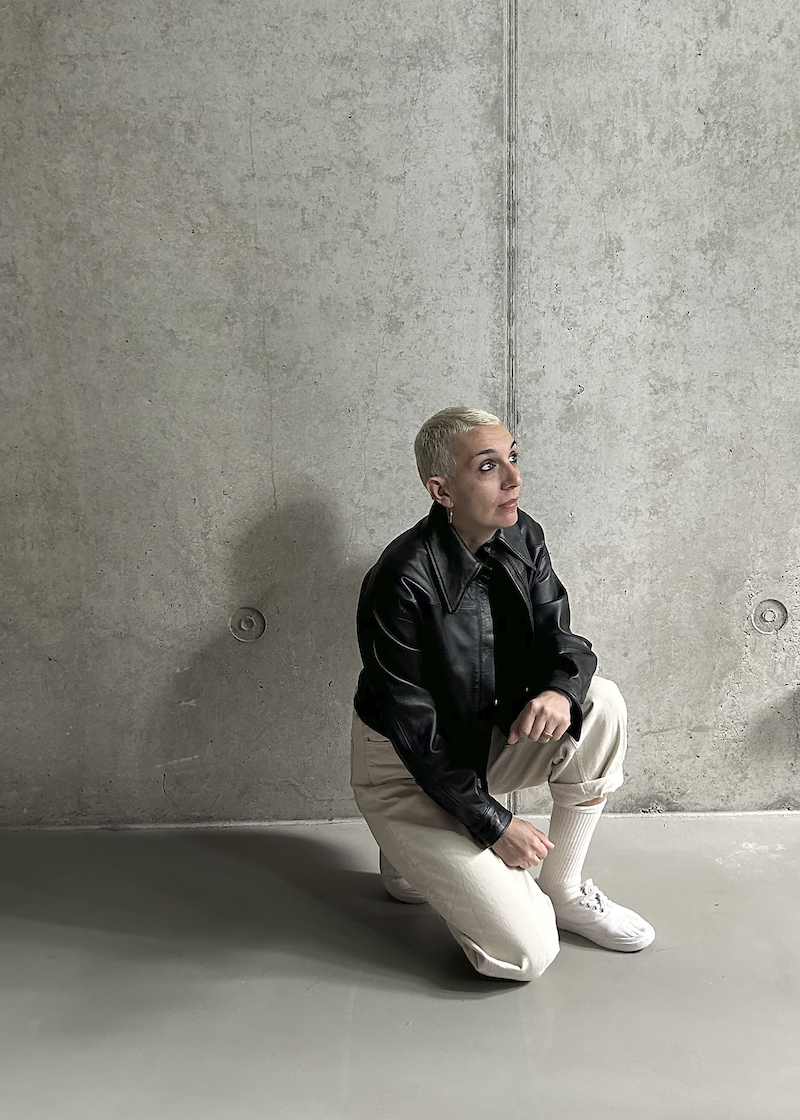
Giulia Bruno is an artist based in Berlin who works with media languages, photography, and video. Her artistic research focuses on themes such as technology, political and cultural activism, with particular attention to the definition of Nature and Language and the contradictions that arise in their interactions. Her work explores artificial and natural landscapes, addressing topics like climate change, the relationship between life and science, pop culture, biodiversity, and language. Her artworks have been exhibited internationally, and in 2018, her artistic research on language as a technological act was selected for ArtReview's "Future Greats." She has recently collaborated with Armin Linke on the exhibition "Earth Indices" in partnership with scientists from the Anthropocene Working Group at the Haus Der Kulturen Der Welt.
giuliabruno.com/Armin Linke
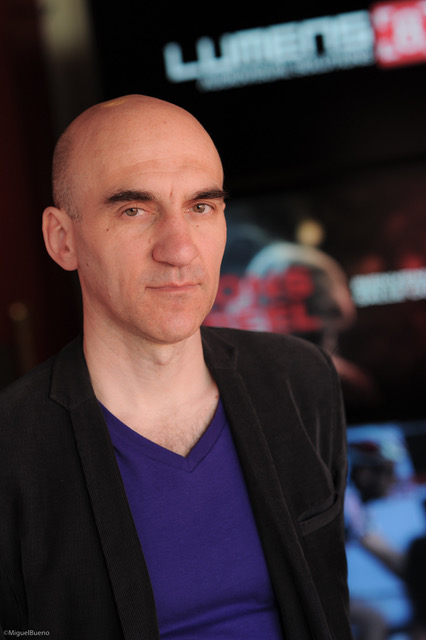
PArmin Linke has documented for over twenty years how humanity uses technologies and knowledge to transform the surface of the Earth and adapt it to its needs. In a collective approach with other creatives, researchers and scientists, the narratives of his works expand on the level of multiple discourses. His works were exhibited internationally. He won the special prize at the 2004 Venice Biennale of Architecture and Image Capital was awarded the Kubus.Sparda Art Prize in 2019.
www.arminlinke.com/Lorenzo Mason

Lorenzo Mason (1983) founded the eponymous Lorenzo Mason Studio in 2020, a multidisciplinary studio engaged in design, research, production, and education. His inquiry is dedicated to experimenting with formats, languages, and techniques, and his work takes shape through an ongoing dialogue with artists, architects, curators, and institutions. AquaGranda is a project in which he has been involved.
www.lorenzomason.studio/Colofon
Scientific Committee:
- Carlo Santagiustina, Research, Methods, and Technology Head
- Costanza Sartoris, Curator
- Luc Steels, Artistic Director
- Massimo Warglien, Scientific Director
Organizing Committee:
- Marco Cosmo, Executive director
- Giulia Saya, Project Manager
- Gabriella Traviglia, Program Manager
- Erica Villa, Curator
Special thanks for providing materials and participating in the Operational Stratigraphies workshop:
- Alessandra Bascià (Venice Fire department)
- Stefania Battaggia (Municipality of Venice)
- Tiziano Bolpin (Municipality of Venice)
- Silvia Bortolato (Municipality of Venice)
- Marino Boscolo (Civil Protection)
- Alberto Bovo (Civil Protection)
- Filippo Cammarata (Civil Protection)
- Maurizio Carlin (Municipality of Venice)
- Barbara Casavecchia (Curator)
- Marco Cosmo (DVRI)
- Nicolò Falcone (Municipality of Venice)
- Christian Ferrarin (CNR ISMAR)
- Pierandrea Malfi (Civil Protection)
- Walter Mutti (Newsstand)
- Roberto Nardin (Traghetto Molo)
- Saverio Pastor (Le Forcole)
- Fabio Penzo (VERITAS)
- Carlo R. M. A. Santagiustina (Ca’ Foscari University and VIU)
- Giulia Saya (DVRI)
- Riccardo Seccarello (VERITAS)
- Luc Steels (VIU)
- Francesco Vascellari (Civil Protection)
- Giuseppe Vianello (Civil Protection)
- Alessandro Zennaro (Civil Protection)
- Maurizio Zennaro (Civil Protection)
Partners
ORGANIZED BY:
FROM A PROJECT BY:
UNDER THE PATRONAGE OF:
WITH THE SUPPORT OF:
MEDIA PARNTER:
Technical Partners:
Fanno parte del DVRI:
- Accademia di Belle Arti di Venezia, Centro Tedesco di Studi Veneziani, CNR - Consiglio Nazionale Ricerche, Conservatorio di Musica Benedetto Marcello, Consorzio Ricerche Lagunari, Fondazione Bevilacqua La Masa, Fondazione Musei Civici di Venezia, Fondazione Querini Stampalia Onlus, Fondazione Ugo e Olga Levi Onlus, Istituto Salesiano Universitario Venezia, IUAV - Università IUAV Architettura Venezia, M9 District s.r.l, Ocean Space, P.E.R. Venezia Consapevole, Università Ca' Foscari Venezia, Venice International University, Venice International Centre for the Environment and Culture Onlus

